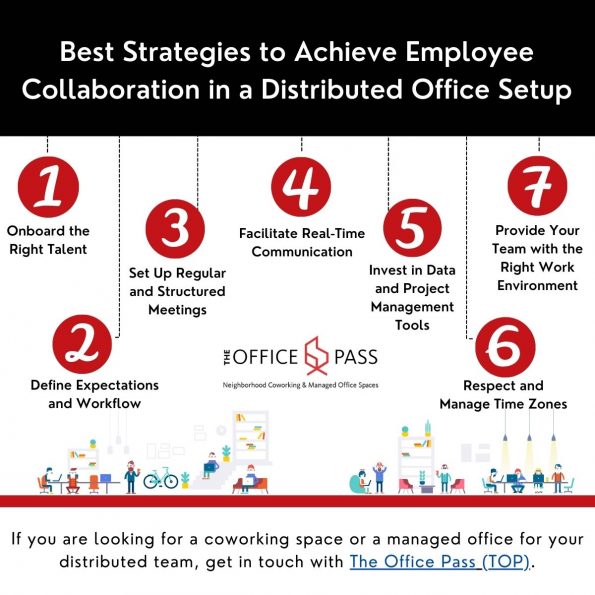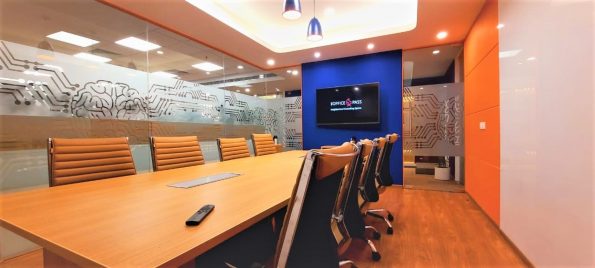Distributed offices are a rising trend among businesses, and why not. In this work model, you have a hybrid workforce that operates from different domestic or international locations. While some of your teams work from the corporate office, others operate from home offices, coworking spaces, managed offices, and the like.
Hybrid teams and distributed offices are the future of work, say reports. While this model offers a new approach to flexibility and productivity, its success depends hugely on effective collaboration among employees. When you have teams working from multiple locations, you must think out of the box and use effective collaboration strategies.
Let’s look at some of the best strategies you can adopt to facilitate employee collaboration in a distributed office.
7 Best Strategies to Achieve Employee Collaboration in a Distributed Office Setup
- Onboard the Right Talent
- Define Expectations and Workflow
- Set Up Regular and Structured Meetings
- Facilitate Real-Time Communication
- Invest in Data and Project Management Tools
- Respect and Manage Time Zones
- Provide Your Team with the Right Work Environment
1. Onboard the Right Talent
The first step is to hire the right talents for your distributed office. Remember – not everyone is cut out for this work model. Your employees will be working from remote locations, often without any direct supervision. So, you must pay special attention to hire self-motivated individuals.
People working from distributed offices must also be excellent team players. It is also recommended to onboard tech-savvy individuals and fast learners since employee collaboration in a distributed office often involves learning to use new technologies, digital resources, and software.
2. Define Expectations and Workflow
A disadvantage of this work model is that it doesn’t make room for non-verbal cues, such as situational prompts, body language, reading between the lines, etc. As a result, employees working in a distributed office are likely to misunderstand each other or overlook important information.
For your distributed teams to collaborate effectively, you must define the expectations and workflow clearly and unambiguously. Make sure that you clarify, define, and explain every aspect of the work environment, starting from the working hours and communication channels to deadlines, goals, and other metrics.

3. Set Up Regular and Structured Meetings
Regular and structured meetings serve as a great employee collaboration strategy in the distributed office setup. Unlike in a traditional office, your employees cannot enjoy the benefits of spontaneous communication and feedback while working from different locations. You can compensate for it by holding team meetings regularly – daily or at least twice a week, based on the needs of your team.
While holding daily or weekly meetings, make sure that employees get a chance to share the latest updates on their work, goals, and targets. It will help keep everyone in the loop, thereby facilitating effective collaboration in the workplace.
4. Facilitate Real-Time Communication
Real-time communication is a crucial factor contributing to the success of the distributed office model. You must use the right tools and employee collaboration software using which your teams can communicate, ideate, and solve problems in real-time.
Video chats and conferences are great tools to facilitate real-time collaboration among employees working from diverse locations. Zoom, Slack, Google Meet, Microsoft Teams, and GoToMeeting, are some of the best video conferencing and instant messaging tools you can use to encourage real-time communication.

5. Invest in Data and Project Management Tools
Access to business data and insights is also crucial in promoting effective employee collaboration in a distributed office. It is a good idea to invest in some cloud-based tools and software to share and manage data and information. Project management tools are also a great choice for enhancing long-distance collaboration.
From file management apps like Google Drive and DropBox to project management software like Trello, your options are plenty. You can choose one based on the size and requirements of your team and your budget, but make sure that it has ample security features.
Also Read: How Do Coworking Spaces Help Startups and Entrepreneurs Reduce Costs?
6. Respect and Manage Time Zones
When you have teams working from different continents, it is important to respect and manage the time zone difference. The good news is that you can use it to your advantage – by planning the work hours and workflow with some extra care, you can ensure round-the-clock productivity.
For starters, take special care to schedule meetings during everyone’s work hours. You can also record the meetings for employees who are not able to attend. Apps like the World Time Buddy are specifically designed for geographically distributed teams – you can use it to find the best time to schedule meetings.
7. Provide Your Team with the Right Work Environment
Distributed offices help decentralize business activities, but your teams still need a workplace. Not everyone has the luxury of working from a well-equipped home office, devoid of distractions. That’s why it is important to invest in non-traditional workspaces that are conducive to employee collaboration.
Coworking spaces and managed offices are great choices for SMEs and corporates planning to decentralize their business activities. The greatest advantage of coworking is that your team gets a professional office space complete with all amenities and tools required for collaboration.
Final Thoughts
Managing a hybrid workforce spread across multiple locations might seem like a daunting task. However, with the right employee collaboration strategy and tools, you can enhance the productivity and performance of your teams.
Above all, don’t forget to provide your team with the right work environment where collaboration happens naturally. If you are looking for a coworking space or a managed office for your distributed team, get in touch with The Office Pass (TOP) right away.



